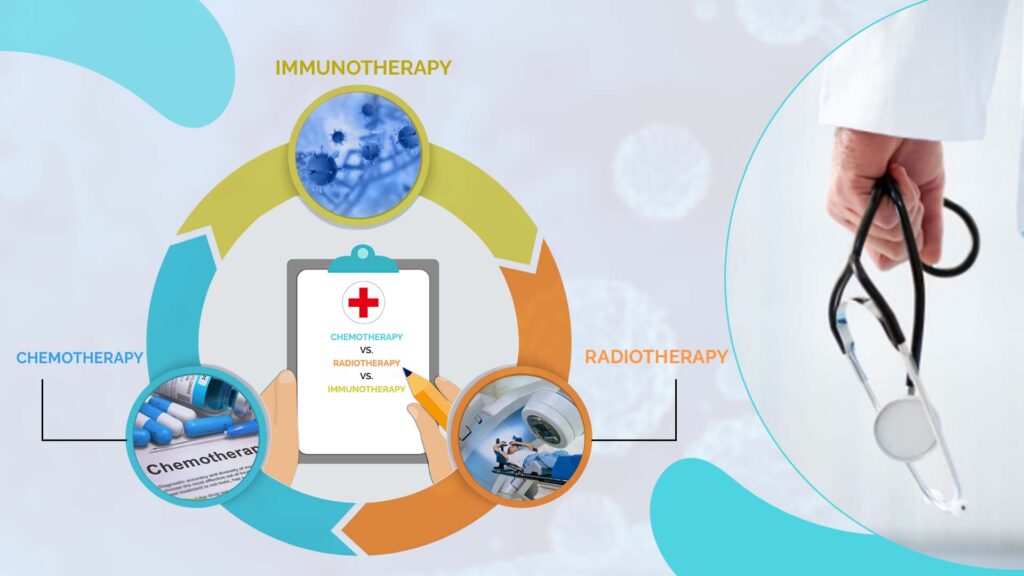A cancer diagnosis can be terrifying and life-altering. But, there exists a solution. There are many therapy options available to combat cancer and stop its growth.
Chemotherapy and radiation are two of the most common cancer treatments. But, there’s one more treatment which exists – Immunotherapy. These three styles of therapy are distinct in their style and have different focuses.
We’ll describe how these therapies operate, how they differ, and what adverse effects they can have in this article.
What is chemotherapy?
Chemotherapy is the first-line treatment for a wide variety of cancers. However, the term “chemotherapy” may refer to any medicine used to treat an illness.
Chemotherapeutic agents are a broad class of medications that can slow or stop cell growth. These agents are used in chemotherapy. The majority of them are directed at rapidly developing cells that divide and multiply. They do not discriminate between healthy and malignant cells.
Chemotherapy’s purpose is to slow or stop cancer growth. To prevent it from spreading to other parts of the body through metastasis.
Chemotherapy comes in a variety of forms, each of which works slightly in a different manner. Antimetabolites, for example, target cell components required for DNA or RNA production. Whereas alkylating medicines target proteins in cancer cells.
Traditionally, chemo is administered in a hospital or clinic by an intravenous (IV) drip. Some chemotherapy medications are now available in tablet form.
What is radiation therapy?
Doctors target cancerous cells with high-energy waves such as X-rays or subatomic particles. It, like chemotherapy, may kill both malignant and healthy cells. Radiation and chemotherapy are often combined by healthcare practitioners to boost their effectiveness.
The three main types of radiation therapy are as follows:
External Radiation: A physician directs the radiation on the tumour from outside.
Internal radiation: To target tumour cells, medical personnel insert a radiation source inside the body. Most internal radiation types become less radioactive over time. Physicians may choose to leave the implanted radiation in place or remove it later.
Systematic Radiation: Radiation is given to a patient systemically by an IV infusion or pill.
Radiation treatment might be the first line of defence against the spread of some early-stage cancer.
In the case of other malignancies, radiation therapy may be used to reduce the tumour before surgery.
Even if radiation cannot always cure cancer, it can sometimes help some people with terminal cancer manage their symptoms.
What is Immunotherapy for cancer?
Immunotherapy works by activating the immune system of the patient so that it can combat the disease. It gives the immune system the ability to identify, target, and eradicate cancer cells. Immunotherapy attempts to strengthen the immune system’s inherent abilities to fight the disease.
Immunotherapy can be administered on its own or in conjunction with other cancer therapies. It is the most promising new cancer therapy strategy since the first chemotherapies were created in the 1940s. It’s been demonstrated to be an effective treatment for patients with diverse types of malignancies.
Immunotherapy medications assist your immune system in recognising and destroying cancer. The ultimate aim of immunotherapy is to develop a set of T cells that are especially directed against cancer. A unique class of white blood cell known as a T cell fights off foreign intruders.
Research in immunotherapy is developing rapidly. Many scientists are hopeful that it could result in advancements in the treatment of cancer. Read more about Immunotherapy
Difference between cancer therapies
The main difference between chemotherapy, radiation therapy and Immunotherapy is how these treatments are delivered.
Chemotherapy is a form of cancer treatment that uses drugs to eradicate cancer cells. Generally, it is taken orally or administered through infusion into a vein or medicine port.
Chemotherapy medications come in a wide variety of forms. The kind that is most beneficial for treating your particular type of cancer is all told to you by your doctor.
Depending on the type you receive, chemotherapy can have a wide range of adverse effects.
Radiation therapy is directing high-energy radiation beams directly into a tumour. The radiation beams cause the tumor’s DNA to alter, causing it to shrink or die.
Because it only targets one part of the body, this sort of cancer treatment has less adverse effects than chemotherapy.
Immunotherapy works on patients’ immune systems to treat them. Immunotherapy can improve the body’s immunological response and teach the immune system how to recognise and eliminate cancer cells.
Side effects
All three methods of treatment have the potential to induce minor to severe side effects.
Chemotherapy targets fast dividing cells, such as cancer cells, but it can also harm other rapidly dividing cells in your body, such as hair, skin, blood, and intestinal cells.
Damage to these cells can result in a variety of side effects, including nausea, hair loss, and mouth sores. Fatigue is the most prevalent side effect of chemotherapy.
Because radiation therapy focuses on a single part of your body, it may cause less adverse effects than chemotherapy. However, it may still have an impact on healthy cells in your body.
Radiation side effects may include nausea, vomiting, stomach cramps, diarrhoea, skin changes, hair loss, and exhaustion.
Many immunotherapy adverse effects are caused by your immune system being overactivated. Mild side effects may include nausea, flu-like symptoms, or an injection site response. In more severe cases, your immune system may assault your organs.
Effectiveness of each treatment
The effects of chemotherapy persist for as long as the medications are present in the body. Furthermore, some research suggests that specific types and doses of chemotherapy can boost immune responses against malignancies. This provides another reason to combine these treatments in some circumstances.
Radiation therapy is also effective depending upon the type of cancer one has. However, every treatment comes with its own dose of side effects and what works for one person isn’t necessary that will work for someone else too.
One of the most intriguing and breakthrough characteristics of immunotherapy is that it can provide long-term cancer protection. This is due to the immune system’s ability to recognise and remember what cancer cells look like. This immunological “memory” is what allows for longer-lasting remissions. Clinical studies have demonstrated that positive responses to cancer immunotherapy treatment. It can be long-lasting and can last even after the treatment is finished.
Conclusion
Chemotherapy, Radiation therapy and immunotherapy are types of cancer medication therapies. Immunotherapy seeks to improve the activity of your immune system so that it can attack cancer cells. Chemotherapy directly limits cancer cells’ capacity to multiply themselves. Radiation therapy like chemotherapy also limits cancer cells’ ability to multiply but differs with the way it’s delivered.
All three methods of treatment have the potential to be effective in the treatment of cancer. They can be used alone or in combination with other cancer treatments. Discuss treatment choices with your doctor to see which solutions are appropriate for your case.



























